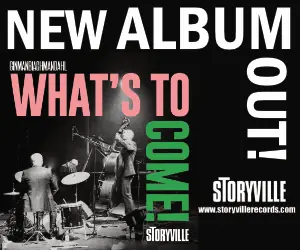The best modern jazz musicians gravitated to the West Coast in the 50s. No matter where you originated, you then became a West Coast musician. Consequently the West Coast pool of saxophonists, beginning with Shank, Pepper and Herb Geller and continuing through to Bob Gordon and Mulligan, became the best in the world. Getz, very much an Easterner, was outrageously re-catalogued as a Westerner when he moved to Los Angeles.
The least celebrated but possibly the most gifted of the saxes was altoist Lennie Niehaus. Niehaus could do anything. He was the most gifted and eloquent alto soloist since Parker and although he was by no means as inspired an arranger as, say, Quincy Jones, his writing techniques were perfect.
Why is he not better known? Probably because he did most of his recordings in the decade from 1952 to 1962, the vast majority of them as a sideman in Stan Kenton’s Orchestra. He was one of Stan’s many great soloists and, predominantly, one of the band’s busiest arrangers, but got lost in the crowd of Stan’s great players. He also gained renown as Clint Eastwood’s first-choice arranger for his film soundtracks, which further obscured his soloing.
He recorded effectively with his own small groups between 1954 and 1957, making eight albums, all of which are included in this new set. Most of Lennie’s recordings, including those here, were issued on the Contemporary label. They feature typically skilled and polished groups varying from quintet to nonet, usually with Monty Budwig and Shelly Manne at their root.
Niehaus gives an explosive example of what’s in store here with the second track, the 1954 Prime Cut – like most of these 80 tracks, a composition of his own. Some of his runs on Prime Cut would, one might think, bring on lockjaw for anyone else who could accomplish them. I don’t think I have heard before such high-quality improvisations delivered by such great technique and he makes his Parker-based inventions sound deceptively easy.
The writing is tight, dazzling and designed to showcase the leader in the small solo spaces available. The 12 tracks by the two octets are the most rewarding and are included in the third and fourth CDs. Blues For Susie has good Rosolino, superbly backed by Mitchell and Lewis. It’s followed by a cracking version of Four with Rosolino, the always good Perkins and the leader again outstanding.
Pepper Adams’s energy-stuffed baritone solos were always a bit better than anyone else offered on the instrument and it’s a wonderful extra to have him and Bob Gordon appearing throughout.
Hampton Hawes’ The Sermon benefits hugely from the excellent scoring and lifts the ennui that is beginning to set in after eight albums of such unrelenting discipline. But make no mistake, the collection is a fine set of “hot”and swinging cool jazz and these days it’s very rare to be able to pick up anything as good as this that one is not already familiar with. I’d certainly have been wrestling with this in days gone by when we picked the records of the year.
Discography
CD1: (1) I’ll Take Romance; Prime Rib; Inside Out; Bottoms Up; You Stepped Out Of A Dream; Whose Blues?; I Remember You; Day By Day; (2) Figure 8; How About You; Patty-Cake; The Way You Look Tonight; Seaside; The Day We Called It A Day; Have You Met Miss Jones?; Night; (3) Rick’s Tricks; Bunko; Nice Work If You Can Get It; You And The Night And The Music; (12) Funny Frank; That’s Rich; You Are There (78.04)
CD2: Blue Room; Love Is Here To Stay; Yes, Yes, Honey; Circling The Blues; (4) They Say It’s Wonderful; Cooling It; Rose Room; Debbie; (5) Easy Living; All The Things You Are; Rondo; (6) Star Eyes; If I Should Lose You; Full House; Crosswalk; Troubled Waters; (7) More Than The Blues; Just One Of Those Things; My Heart Stood Still; Lens (69.43)
CD3: (8) Thou Swell; I Wished On The Moon; Knee Deep; Fond Memories; Take It From Me; Belle Of The Ball; As Long As I Live; Ill Wind; Three Of A Kind; Elbow Room; (9) Poinciana; Happy Times; I Should Care; I Can’t Believe That You’re In Love With Me; (10) Blues For Susie; Four; The Sermon; With The Wind And The Rain In Your Hair (56.49)
CD4: (11) P & L; I See Your Face Before Me; Four Eleven West; Soon; Little Girl Blues; Don’t You Know I Care?; He Ain’t Got Rhythm; Kiss Me And Kill Me With Love; (13) Turbulence; Folly; Multiplicity; Backlash; Outpost; Maybe Next Year; Conversation Piece; Low Clearance; (14) Dollar Day; Easy Terms; Minor Accident (69.05)
Niehaus (as) in Los Angeles with:
(1) Jack Montrose (ts); Bob Gordon (bar); Monty Budwig (b); Shelly Manne (d). July 1954.
(2) Stu Williamson (t); Bob Enevoldsen (vtb); Montrose (ts); Gordon (bar); Lou Levy (p); Budwig (b); Manne (d). 23 August 1954.
(3) as (2) but Bill Holman (ts) and Jimmy Giuffre (bar) for Montrose and Gordon. Add Pete Jolly (p). 11 January 1955.
(4) same as (3), 26 February 1955.
(5) Budwig (b); Manne (d) plus strings. 16 March 1955.
(6) as (5) plus Bill Perkins (ts) and Gordon (bar). 30 March 1955.
(7) Williamson (t, vtb); Hampton Hawes (p); Budwig (b); Manne (d). 25 April 1955.
(8) Williamson (t, vtb); Perkins (ts, f); Giuffre (bar); Buddy Clark (b); Manne (d). 12 January 1956.
(9) Williamson (t, vtb); Hawes (p); Red Mitchell (b); Manne (d). 20 January 1956.
(10) Frank Rosolino (tb); Vince DeRosa (frh); Jay McAllister (tu); Perkins (ts); Pepper Adams (bar); Red Mitchell (b); Mel Lewis (d). 10 December 1956.
(11) Ed Leddy (t); Kenny Shroyer (tb); Perkins (ts); Steve Perlow (bar); Levy (p); Red Kelly (b); Jerry McKenzie (d). 1 October 1957.
(12) Conte Candoli (t); Frank Rosolini (tb); Richie Kamuca (ts); Adams (bar); Dick Shreve (p); Howard Rumsey (b); Stan Levey (d). 12 March 1957.
(13) Duane Tatro’s Jazz For Moderns with Williamson, Enevoldsen, Holman, Giuffre, Manne and others. 4 April 1955.
(14) similar to (13), 1 November 1955.
Essential Jazz Classics EJC 55776

















